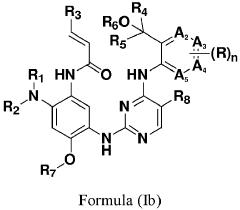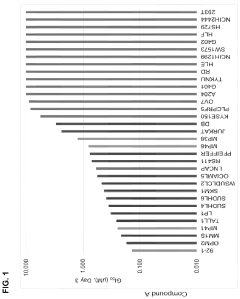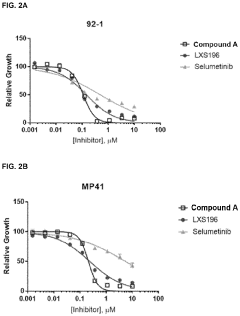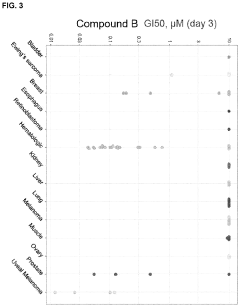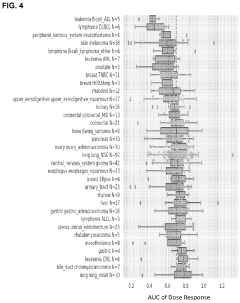The Role of Geometric Isomers in Environmental Bioaccumulation Studies
AUG 1, 20259 MIN READ
Generate Your Research Report Instantly with AI Agent
Patsnap Eureka helps you evaluate technical feasibility & market potential.
Geometric Isomers in Bioaccumulation: Background and Objectives
Geometric isomers, molecules with the same molecular formula but different spatial arrangements of atoms, have emerged as a critical focus in environmental bioaccumulation studies. The significance of these structural variations lies in their potential to influence the behavior and fate of chemicals in ecosystems. Over the past decades, researchers have increasingly recognized that the spatial configuration of molecules can dramatically affect their bioaccumulation potential, toxicity, and environmental persistence.
The evolution of this field has been driven by advancements in analytical chemistry and environmental toxicology. Early studies often overlooked the importance of geometric isomerism, treating structurally similar compounds as equivalent in environmental assessments. However, as our understanding of molecular interactions and biological processes has deepened, the distinct roles of geometric isomers have come to the forefront of environmental research.
The primary objective of studying geometric isomers in bioaccumulation is to elucidate how subtle structural differences can lead to significant variations in environmental behavior. This includes investigating differences in uptake rates, metabolic processes, and accumulation patterns across various organisms and trophic levels. By understanding these nuances, researchers aim to develop more accurate models for predicting the environmental fate of chemicals and their potential impacts on ecosystems.
Another key goal is to refine risk assessment protocols for environmental contaminants. Traditional approaches often fail to account for isomer-specific effects, potentially leading to under- or overestimation of environmental risks. By incorporating geometric isomer considerations into regulatory frameworks and environmental monitoring programs, scientists and policymakers seek to enhance the precision and effectiveness of environmental protection strategies.
Furthermore, the study of geometric isomers in bioaccumulation has implications for the design and development of new chemicals. As industries strive for more environmentally friendly products, understanding how molecular geometry influences bioaccumulation can guide the synthesis of compounds with reduced environmental impact. This aligns with the broader trend towards green chemistry and sustainable industrial practices.
The technological trajectory in this field is moving towards more sophisticated analytical techniques capable of distinguishing and quantifying geometric isomers in complex environmental matrices. Advances in high-resolution mass spectrometry, chiral chromatography, and computational modeling are enabling researchers to probe deeper into the mechanisms underlying isomer-specific bioaccumulation processes.
The evolution of this field has been driven by advancements in analytical chemistry and environmental toxicology. Early studies often overlooked the importance of geometric isomerism, treating structurally similar compounds as equivalent in environmental assessments. However, as our understanding of molecular interactions and biological processes has deepened, the distinct roles of geometric isomers have come to the forefront of environmental research.
The primary objective of studying geometric isomers in bioaccumulation is to elucidate how subtle structural differences can lead to significant variations in environmental behavior. This includes investigating differences in uptake rates, metabolic processes, and accumulation patterns across various organisms and trophic levels. By understanding these nuances, researchers aim to develop more accurate models for predicting the environmental fate of chemicals and their potential impacts on ecosystems.
Another key goal is to refine risk assessment protocols for environmental contaminants. Traditional approaches often fail to account for isomer-specific effects, potentially leading to under- or overestimation of environmental risks. By incorporating geometric isomer considerations into regulatory frameworks and environmental monitoring programs, scientists and policymakers seek to enhance the precision and effectiveness of environmental protection strategies.
Furthermore, the study of geometric isomers in bioaccumulation has implications for the design and development of new chemicals. As industries strive for more environmentally friendly products, understanding how molecular geometry influences bioaccumulation can guide the synthesis of compounds with reduced environmental impact. This aligns with the broader trend towards green chemistry and sustainable industrial practices.
The technological trajectory in this field is moving towards more sophisticated analytical techniques capable of distinguishing and quantifying geometric isomers in complex environmental matrices. Advances in high-resolution mass spectrometry, chiral chromatography, and computational modeling are enabling researchers to probe deeper into the mechanisms underlying isomer-specific bioaccumulation processes.
Market Demand for Bioaccumulation Studies
The market demand for bioaccumulation studies focusing on geometric isomers has been steadily increasing in recent years, driven by growing environmental concerns and stricter regulatory requirements. Environmental agencies, pharmaceutical companies, and chemical manufacturers are the primary stakeholders fueling this demand, as they seek to better understand the fate and impact of chemicals in ecosystems.
Regulatory bodies worldwide have recognized the importance of considering geometric isomers in environmental risk assessments. The European Chemicals Agency (ECHA) and the United States Environmental Protection Agency (EPA) have both updated their guidelines to include specific requirements for assessing the bioaccumulation potential of geometric isomers. This regulatory push has created a significant market for specialized bioaccumulation studies that can differentiate between isomeric forms.
The pharmaceutical industry has emerged as a major driver of demand for these studies. With the increasing prevalence of chiral drugs, understanding the environmental fate of different geometric isomers has become crucial for drug development and approval processes. Pharmaceutical companies are investing heavily in research to assess the bioaccumulation potential of drug candidates and their metabolites, including geometric isomers, to ensure environmental safety and comply with regulatory standards.
Agricultural chemical manufacturers represent another significant market segment. The use of pesticides and herbicides with geometric isomers has raised concerns about their potential for bioaccumulation in food chains. As a result, there is a growing demand for studies that can accurately predict the environmental behavior of these compounds, taking into account their isomeric forms.
The aquaculture industry has also shown increased interest in bioaccumulation studies of geometric isomers. As fish farms become more prevalent, understanding the accumulation of various chemical compounds, including their isomeric forms, in farmed fish has become essential for ensuring food safety and environmental protection.
Environmental consulting firms have reported a surge in requests for specialized bioaccumulation assessments that consider geometric isomers. These firms are expanding their capabilities to meet this demand, investing in advanced analytical techniques and modeling tools to provide comprehensive assessments of isomeric compounds in various environmental matrices.
Academic institutions and research organizations are also contributing to the market growth by developing new methodologies and tools for studying geometric isomer bioaccumulation. This research is often funded by government grants or industry partnerships, reflecting the broader societal interest in understanding and mitigating the environmental impacts of these compounds.
As awareness of the role of geometric isomers in environmental processes continues to grow, the market for specialized bioaccumulation studies is expected to expand further. This trend is likely to drive innovation in analytical techniques, modeling approaches, and experimental designs tailored to the unique challenges posed by geometric isomers in environmental systems.
Regulatory bodies worldwide have recognized the importance of considering geometric isomers in environmental risk assessments. The European Chemicals Agency (ECHA) and the United States Environmental Protection Agency (EPA) have both updated their guidelines to include specific requirements for assessing the bioaccumulation potential of geometric isomers. This regulatory push has created a significant market for specialized bioaccumulation studies that can differentiate between isomeric forms.
The pharmaceutical industry has emerged as a major driver of demand for these studies. With the increasing prevalence of chiral drugs, understanding the environmental fate of different geometric isomers has become crucial for drug development and approval processes. Pharmaceutical companies are investing heavily in research to assess the bioaccumulation potential of drug candidates and their metabolites, including geometric isomers, to ensure environmental safety and comply with regulatory standards.
Agricultural chemical manufacturers represent another significant market segment. The use of pesticides and herbicides with geometric isomers has raised concerns about their potential for bioaccumulation in food chains. As a result, there is a growing demand for studies that can accurately predict the environmental behavior of these compounds, taking into account their isomeric forms.
The aquaculture industry has also shown increased interest in bioaccumulation studies of geometric isomers. As fish farms become more prevalent, understanding the accumulation of various chemical compounds, including their isomeric forms, in farmed fish has become essential for ensuring food safety and environmental protection.
Environmental consulting firms have reported a surge in requests for specialized bioaccumulation assessments that consider geometric isomers. These firms are expanding their capabilities to meet this demand, investing in advanced analytical techniques and modeling tools to provide comprehensive assessments of isomeric compounds in various environmental matrices.
Academic institutions and research organizations are also contributing to the market growth by developing new methodologies and tools for studying geometric isomer bioaccumulation. This research is often funded by government grants or industry partnerships, reflecting the broader societal interest in understanding and mitigating the environmental impacts of these compounds.
As awareness of the role of geometric isomers in environmental processes continues to grow, the market for specialized bioaccumulation studies is expected to expand further. This trend is likely to drive innovation in analytical techniques, modeling approaches, and experimental designs tailored to the unique challenges posed by geometric isomers in environmental systems.
Current Challenges in Geometric Isomer Analysis
The analysis of geometric isomers in environmental bioaccumulation studies faces several significant challenges that hinder accurate assessment and interpretation of data. One of the primary obstacles is the complexity of sample matrices encountered in environmental samples. Natural environments contain a myriad of organic compounds, many of which can interfere with the detection and quantification of geometric isomers.
Separation and identification of geometric isomers pose another major challenge. These compounds often have identical molecular masses and similar chemical properties, making their chromatographic separation difficult. Traditional analytical techniques may not provide sufficient resolution to distinguish between different isomers, leading to potential misidentification or underestimation of specific isomeric forms.
The dynamic nature of isomerization processes in the environment further complicates analysis. Geometric isomers can interconvert under various environmental conditions, such as exposure to light or changes in pH. This instability makes it challenging to determine the original isomeric composition of a sample and to track the fate of specific isomers over time.
Standardization of analytical methods for geometric isomers remains an ongoing challenge. The lack of universally accepted protocols for sample preparation, extraction, and analysis can lead to inconsistencies in results across different studies and laboratories. This variability hampers the comparability of data and the establishment of reliable bioaccumulation factors for different isomeric forms.
The development of suitable reference materials and standards for geometric isomers is another area of concern. Many environmental studies rely on commercially available standards, which may not accurately represent the isomeric ratios found in real environmental samples. This discrepancy can lead to errors in quantification and interpretation of bioaccumulation data.
Sensitivity and detection limits of analytical instruments also present challenges, particularly when dealing with trace levels of geometric isomers in complex environmental matrices. The ability to detect and quantify low concentrations of individual isomers is crucial for understanding their environmental fate and potential biological impacts.
Lastly, the interpretation of bioaccumulation data for geometric isomers is complicated by the potential for selective uptake, metabolism, and excretion of different isomeric forms by organisms. These biological processes can alter the isomeric ratios observed in environmental samples, making it difficult to establish clear relationships between environmental concentrations and bioaccumulation patterns.
Separation and identification of geometric isomers pose another major challenge. These compounds often have identical molecular masses and similar chemical properties, making their chromatographic separation difficult. Traditional analytical techniques may not provide sufficient resolution to distinguish between different isomers, leading to potential misidentification or underestimation of specific isomeric forms.
The dynamic nature of isomerization processes in the environment further complicates analysis. Geometric isomers can interconvert under various environmental conditions, such as exposure to light or changes in pH. This instability makes it challenging to determine the original isomeric composition of a sample and to track the fate of specific isomers over time.
Standardization of analytical methods for geometric isomers remains an ongoing challenge. The lack of universally accepted protocols for sample preparation, extraction, and analysis can lead to inconsistencies in results across different studies and laboratories. This variability hampers the comparability of data and the establishment of reliable bioaccumulation factors for different isomeric forms.
The development of suitable reference materials and standards for geometric isomers is another area of concern. Many environmental studies rely on commercially available standards, which may not accurately represent the isomeric ratios found in real environmental samples. This discrepancy can lead to errors in quantification and interpretation of bioaccumulation data.
Sensitivity and detection limits of analytical instruments also present challenges, particularly when dealing with trace levels of geometric isomers in complex environmental matrices. The ability to detect and quantify low concentrations of individual isomers is crucial for understanding their environmental fate and potential biological impacts.
Lastly, the interpretation of bioaccumulation data for geometric isomers is complicated by the potential for selective uptake, metabolism, and excretion of different isomeric forms by organisms. These biological processes can alter the isomeric ratios observed in environmental samples, making it difficult to establish clear relationships between environmental concentrations and bioaccumulation patterns.
Existing Methodologies for Isomer Differentiation
01 Geometric isomers and their impact on bioaccumulation
Geometric isomers can have different bioaccumulation properties due to their structural differences. The spatial arrangement of atoms in these isomers can affect their interaction with biological systems, leading to variations in their accumulation in organisms. This difference in bioaccumulation can have significant implications for environmental and toxicological studies.- Geometric isomers and their impact on bioaccumulation: Geometric isomers can have different bioaccumulation properties due to their structural differences. The spatial arrangement of atoms in these isomers can affect their interaction with biological systems, leading to variations in their accumulation in organisms. This difference in bioaccumulation can have significant implications for environmental toxicology and risk assessment.
- Analytical methods for detecting geometric isomers in bioaccumulation studies: Various analytical techniques are employed to detect and quantify geometric isomers in bioaccumulation studies. These methods may include chromatography, spectroscopy, and mass spectrometry. The development of sensitive and specific analytical methods is crucial for accurately assessing the bioaccumulation potential of different geometric isomers in environmental samples and biological tissues.
- Environmental fate and distribution of geometric isomers: The environmental fate and distribution of geometric isomers can vary significantly due to their structural differences. Factors such as solubility, volatility, and persistence can influence how these isomers partition in different environmental compartments. Understanding these processes is essential for predicting the bioaccumulation potential and long-term environmental impacts of geometric isomers.
- Biotransformation of geometric isomers and its effect on bioaccumulation: The biotransformation of geometric isomers in living organisms can significantly affect their bioaccumulation potential. Different isomers may undergo varying rates and pathways of metabolism, leading to differences in their persistence and accumulation in biological tissues. This aspect is crucial for understanding the overall bioaccumulation behavior of geometric isomers in food chains and ecosystems.
- Regulatory considerations for geometric isomers in bioaccumulation assessment: Regulatory frameworks for assessing the bioaccumulation potential of chemicals often need to consider the specific properties of geometric isomers. This may involve developing specific guidelines for testing and evaluating the bioaccumulation of these compounds. The regulatory approach to geometric isomers can have important implications for chemical registration, risk assessment, and environmental protection strategies.
02 Analytical methods for distinguishing geometric isomers
Various analytical techniques are employed to differentiate between geometric isomers and assess their bioaccumulation potential. These methods may include chromatographic separation, spectroscopic analysis, and advanced imaging techniques. The ability to accurately identify and quantify different geometric isomers is crucial for understanding their environmental fate and potential biological effects.Expand Specific Solutions03 Environmental persistence of geometric isomers
The environmental persistence of geometric isomers can vary, affecting their long-term bioaccumulation potential. Factors such as chemical stability, reactivity, and degradation rates in different environmental compartments play a role in determining the persistence of these compounds. Understanding these factors is essential for predicting the environmental behavior and potential risks associated with geometric isomers.Expand Specific Solutions04 Bioaccumulation differences in aquatic and terrestrial ecosystems
Geometric isomers may exhibit different bioaccumulation patterns in aquatic and terrestrial ecosystems. The physical and chemical properties of these isomers can influence their distribution, uptake, and accumulation in various organisms. Studying these differences is crucial for assessing the potential ecological impacts and developing appropriate risk assessment strategies.Expand Specific Solutions05 Regulatory considerations for geometric isomers in bioaccumulation studies
Regulatory frameworks and guidelines for assessing the bioaccumulation potential of geometric isomers are being developed and refined. These considerations aim to address the unique challenges posed by geometric isomers in environmental risk assessments. Standardized protocols and criteria for evaluating the bioaccumulation of these compounds are essential for ensuring consistent and reliable regulatory decisions.Expand Specific Solutions
Key Players in Environmental Toxicology Research
The field of geometric isomers in environmental bioaccumulation studies is in a growth phase, with increasing market size and technological advancements. The global environmental testing market, which encompasses this research area, is projected to reach $14.2 billion by 2026. Technological maturity varies among key players, with academic institutions like Zhejiang University and Carnegie Mellon University leading in fundamental research. Companies such as Kurita Water Industries and NAUE GmbH & Co. KG are applying these findings to develop practical solutions. Research organizations like Battelle Savannah River Alliance LLC and The Broad Institute, Inc. are bridging the gap between academic research and industrial applications, driving innovation in environmental bioaccumulation assessment techniques.
Zhejiang University
Technical Solution: Zhejiang University has pioneered research on the role of geometric isomers in environmental bioaccumulation, focusing on aquatic ecosystems. Their approach combines field studies with laboratory experiments to investigate the differential uptake and accumulation of cis- and trans-isomers of various contaminants, including pesticides and flame retardants[4]. The university has developed novel passive sampling devices that can selectively capture different geometric isomers from water and sediment, allowing for long-term monitoring of isomer-specific bioaccumulation patterns[5]. Additionally, they have conducted extensive toxicokinetic studies using model organisms to elucidate the mechanisms underlying isomer-specific bioaccumulation, including differences in absorption, metabolism, and elimination rates between geometric isomers[6]. Their research has revealed significant variations in the bioaccumulation potential of different isomers, highlighting the importance of considering isomeric forms in environmental risk assessments.
Strengths: Comprehensive approach combining field and laboratory studies, innovative sampling techniques. Weaknesses: Limited to aquatic ecosystems, may not fully represent terrestrial bioaccumulation processes.
Battelle Savannah River Alliance LLC
Technical Solution: Battelle Savannah River Alliance LLC has focused on the role of geometric isomers in environmental bioaccumulation within the context of nuclear waste management and environmental remediation. Their research addresses the behavior of radionuclide complexes and their geometric isomers in contaminated ecosystems. The alliance has developed specialized radiochemical separation techniques to isolate and characterize different geometric isomers of metal-organic complexes formed by radionuclides in the environment[13]. These methods allow for the assessment of isomer-specific bioaccumulation in plants and animals inhabiting areas affected by nuclear activities. Battelle researchers have also investigated the influence of geometric isomerism on the mobility and bioavailability of radionuclides in soil and groundwater systems[14]. Their studies have demonstrated that certain geometric isomers of radionuclide complexes exhibit significantly different sorption behaviors and biological uptake rates, which has important implications for long-term environmental risk assessments and remediation strategies.
Strengths: Unique focus on radionuclide bioaccumulation, integration with environmental remediation efforts. Weaknesses: Specialized niche may limit broader applicability, potential security and access restrictions due to nuclear-related research.
Innovative Approaches in Isomer-Specific Bioaccumulation
Erbb/BTK inhibitors
PatentPendingEP4356975A2
Innovation
- Development of compounds represented by Formula (I) and its pharmaceutically acceptable salts, esters, hydrates, and stereoisomers, which are used in pharmaceutical compositions to inhibit ErbB family kinases and BTK, particularly targeting mutant forms to enhance therapeutic efficacy.
Compounds and uses thereof
PatentPendingUS20230145003A1
Innovation
- Development of specific compounds that modulate the BAF complex by inhibiting BRG1 and/or BRM activity, which can be used alone or in combination with other pharmaceutically active agents to treat disorders like cancer.
Regulatory Framework for Environmental Contaminants
The regulatory framework for environmental contaminants plays a crucial role in addressing the challenges posed by geometric isomers in bioaccumulation studies. This framework encompasses a complex network of laws, regulations, and guidelines designed to protect human health and the environment from harmful substances.
At the international level, the Stockholm Convention on Persistent Organic Pollutants (POPs) serves as a cornerstone for regulating persistent and bioaccumulative chemicals. This treaty specifically addresses isomeric compounds, recognizing their unique properties and potential environmental impacts. Signatory countries are required to implement measures to reduce or eliminate the production and use of POPs, including certain geometric isomers.
In the United States, the Environmental Protection Agency (EPA) oversees the regulation of environmental contaminants through various legislative acts. The Toxic Substances Control Act (TSCA) provides the EPA with authority to require reporting, record-keeping, and testing of chemical substances, including geometric isomers. The Clean Water Act and Safe Drinking Water Act also contribute to the regulatory framework by setting standards for water quality and contaminant levels.
The European Union has established the Registration, Evaluation, Authorization, and Restriction of Chemicals (REACH) regulation, which addresses the production and use of chemical substances, including geometric isomers. REACH requires companies to identify and manage the risks associated with substances they manufacture and market in the EU, promoting the principle of substitution for hazardous chemicals.
Regulatory agencies worldwide have developed specific guidelines for assessing the bioaccumulation potential of chemicals, including geometric isomers. These guidelines often incorporate standardized testing protocols, such as the OECD Test Guidelines for bioaccumulation in aquatic and terrestrial organisms. These protocols consider the unique properties of geometric isomers, including their potential for interconversion and differential uptake by organisms.
The regulatory framework also addresses the challenges of analytical methods for detecting and quantifying geometric isomers in environmental samples. Agencies like the EPA and the European Food Safety Authority (EFSA) have established guidelines for the development and validation of analytical methods specific to isomeric compounds, ensuring accurate assessment of environmental contamination and bioaccumulation.
As scientific understanding of geometric isomers and their environmental behavior evolves, regulatory frameworks are continuously updated to incorporate new findings. This adaptive approach ensures that regulations remain effective in protecting ecosystems and human health from the potential risks associated with these complex chemical structures.
At the international level, the Stockholm Convention on Persistent Organic Pollutants (POPs) serves as a cornerstone for regulating persistent and bioaccumulative chemicals. This treaty specifically addresses isomeric compounds, recognizing their unique properties and potential environmental impacts. Signatory countries are required to implement measures to reduce or eliminate the production and use of POPs, including certain geometric isomers.
In the United States, the Environmental Protection Agency (EPA) oversees the regulation of environmental contaminants through various legislative acts. The Toxic Substances Control Act (TSCA) provides the EPA with authority to require reporting, record-keeping, and testing of chemical substances, including geometric isomers. The Clean Water Act and Safe Drinking Water Act also contribute to the regulatory framework by setting standards for water quality and contaminant levels.
The European Union has established the Registration, Evaluation, Authorization, and Restriction of Chemicals (REACH) regulation, which addresses the production and use of chemical substances, including geometric isomers. REACH requires companies to identify and manage the risks associated with substances they manufacture and market in the EU, promoting the principle of substitution for hazardous chemicals.
Regulatory agencies worldwide have developed specific guidelines for assessing the bioaccumulation potential of chemicals, including geometric isomers. These guidelines often incorporate standardized testing protocols, such as the OECD Test Guidelines for bioaccumulation in aquatic and terrestrial organisms. These protocols consider the unique properties of geometric isomers, including their potential for interconversion and differential uptake by organisms.
The regulatory framework also addresses the challenges of analytical methods for detecting and quantifying geometric isomers in environmental samples. Agencies like the EPA and the European Food Safety Authority (EFSA) have established guidelines for the development and validation of analytical methods specific to isomeric compounds, ensuring accurate assessment of environmental contamination and bioaccumulation.
As scientific understanding of geometric isomers and their environmental behavior evolves, regulatory frameworks are continuously updated to incorporate new findings. This adaptive approach ensures that regulations remain effective in protecting ecosystems and human health from the potential risks associated with these complex chemical structures.
Ecological Impact Assessment of Geometric Isomers
The ecological impact assessment of geometric isomers is a critical component in understanding their role in environmental bioaccumulation studies. These compounds, which have the same molecular formula but different spatial arrangements of atoms, can exhibit varying degrees of persistence, bioaccumulation, and toxicity in ecosystems.
Geometric isomers often demonstrate distinct behaviors in environmental systems due to their structural differences. This can lead to varying rates of uptake, metabolism, and elimination by organisms, ultimately affecting their bioaccumulation potential. For instance, certain geometric isomers may have a higher affinity for lipids, resulting in increased accumulation in fatty tissues of aquatic organisms.
The assessment of ecological impacts begins with examining the distribution of geometric isomers in different environmental compartments, such as water, sediment, and biota. This distribution pattern can provide insights into the potential exposure routes for various organisms within the ecosystem. Monitoring studies often reveal that some isomers may preferentially accumulate in specific trophic levels or exhibit biomagnification along the food chain.
Toxicity evaluations are essential in determining the ecological risks associated with geometric isomers. These studies typically involve acute and chronic toxicity tests on representative species from different trophic levels. The results often show that toxicity can vary significantly between isomers, with some forms being more harmful than others. This variability underscores the importance of isomer-specific assessments in ecological risk evaluations.
Biomarker studies play a crucial role in assessing the sublethal effects of geometric isomers on organisms. These may include changes in enzyme activities, gene expression patterns, or physiological processes. Such studies can reveal subtle yet significant impacts on organism health and population dynamics, even at concentrations below acute toxicity thresholds.
The persistence of geometric isomers in the environment is another key factor in ecological impact assessment. Some isomers may be more resistant to degradation, leading to long-term exposure and potential chronic effects on ecosystems. This persistence can also result in the transport of these compounds to remote areas, expanding their ecological footprint beyond the initial contamination site.
Ecosystem-level effects of geometric isomers are often complex and challenging to predict. They may include alterations in community structure, changes in species interactions, or shifts in ecosystem functions. Long-term monitoring and ecological modeling are typically employed to capture these broader impacts and to project potential future scenarios under different exposure conditions.
Geometric isomers often demonstrate distinct behaviors in environmental systems due to their structural differences. This can lead to varying rates of uptake, metabolism, and elimination by organisms, ultimately affecting their bioaccumulation potential. For instance, certain geometric isomers may have a higher affinity for lipids, resulting in increased accumulation in fatty tissues of aquatic organisms.
The assessment of ecological impacts begins with examining the distribution of geometric isomers in different environmental compartments, such as water, sediment, and biota. This distribution pattern can provide insights into the potential exposure routes for various organisms within the ecosystem. Monitoring studies often reveal that some isomers may preferentially accumulate in specific trophic levels or exhibit biomagnification along the food chain.
Toxicity evaluations are essential in determining the ecological risks associated with geometric isomers. These studies typically involve acute and chronic toxicity tests on representative species from different trophic levels. The results often show that toxicity can vary significantly between isomers, with some forms being more harmful than others. This variability underscores the importance of isomer-specific assessments in ecological risk evaluations.
Biomarker studies play a crucial role in assessing the sublethal effects of geometric isomers on organisms. These may include changes in enzyme activities, gene expression patterns, or physiological processes. Such studies can reveal subtle yet significant impacts on organism health and population dynamics, even at concentrations below acute toxicity thresholds.
The persistence of geometric isomers in the environment is another key factor in ecological impact assessment. Some isomers may be more resistant to degradation, leading to long-term exposure and potential chronic effects on ecosystems. This persistence can also result in the transport of these compounds to remote areas, expanding their ecological footprint beyond the initial contamination site.
Ecosystem-level effects of geometric isomers are often complex and challenging to predict. They may include alterations in community structure, changes in species interactions, or shifts in ecosystem functions. Long-term monitoring and ecological modeling are typically employed to capture these broader impacts and to project potential future scenarios under different exposure conditions.
Unlock deeper insights with Patsnap Eureka Quick Research — get a full tech report to explore trends and direct your research. Try now!
Generate Your Research Report Instantly with AI Agent
Supercharge your innovation with Patsnap Eureka AI Agent Platform!



